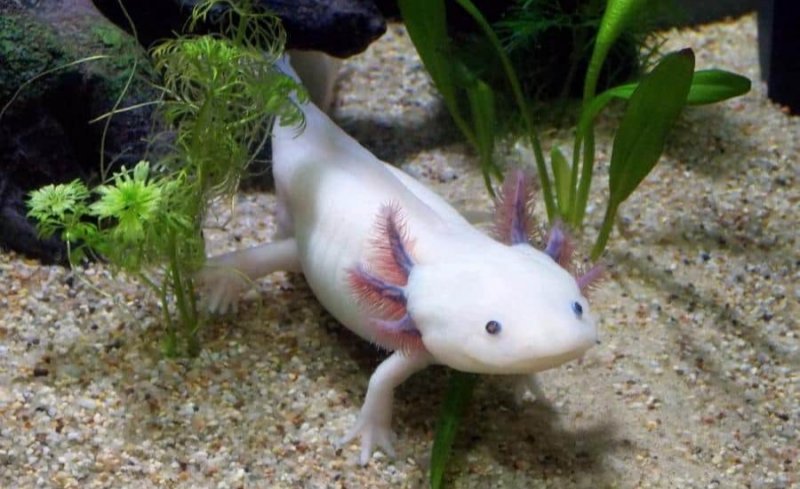Walking Wonders: Exploring the Fascinating World of Fish with Legs
While studying fish anatomy in school, did your teacher ever mention anything about fish having legs or the existence of walking fish?
Typically, we associate fish with not having legs. Since fish live in water, we’ve been taught they don’t have legs.
However, the world is full of secrets, and certain fish with legs and can walk on land. They walk quadrupedally, using their fin-like limbs for support and propulsion. It’s a remarkable phenomenon that challenges our traditional understanding of fish and their capabilities.
Can Fish Really Have Legs?
Fish have features that resemble legs, but they don’t have human legs. Fish use fins to navigate their watery environment. The major fins are pectoral, pelvic, and anal. These fins help fish navigate and control their motions in the water.
The correct words for these fins are “fin rays” or “lobed fins.” They help fish swim, turn, and balance. These fins are a remarkable adaptation that enables fish to thrive in their underwater world.
List of 20 fish with legs
Hemiscyllium Ocellatum
Hemiscyllium ocellatum, also known as the leopard shark or zebra shark, is a fascinating species of cartilaginous fish belonging to the family Hemiscylliidae.
The leopard shark is relatively small yet robust, characterized by its flat body and broad head. Notably, it lacks an anal fin, and its dorsal fins are situated towards the rear of its body.
The first dorsal fin contains a small spine at its tip, whereas the second has one to three keels and no spines.
These sharks reach 1 meter (3 feet 3 inches) and 10 kilograms (22 pounds). Leopard sharks feature dark brown markings on their backs and white dots on their flanks and bellies, giving them their unique appearance.
Leopard sharks inhabit tropical waters in regions like Australia, Indonesia, New Guinea, and northern Queensland. They live on muddy or sandy seabeds from 2 meters (6 feet 7 inches) to 140 meters (460 feet). They feed small fish, shrimp, squid, and crabs underwater.
Axolotl
Axolotls may not be true fish, but they make fantastic additions to fish tanks, so we couldn’t resist talking about them here! The axolotl, also known as the Mexican walking fish, is an incredibly adorable species of salamander native to a couple of lakes in Mexico.
They live underwater because they maintain their gills and webbed feet. Essentially, they are like four-legged fish, and their aquatic lifestyle makes them fascinating creatures to observe.
Unfortunately, these fish-like beings are facing a critical threat in their natural habitat due to pollution, drainage, and other environmental issues. Thus, they are critically threatened. However, they are thriving in the aquarium hobby around the world, where people keep them as pets.
Mexican walking fish are delightful companions as aquarium pets, especially the albino variety, which showcases a striking and eye-catching appearance in freshwater aquariums. To ensure their well-being, it’s essential to maintain cool water conditions and provide them with a tank of at least 20 gallons to thrive and flourish happily.
Lungfish
Lungfish belong to at least six fish species found within the Protopteridae family. These remarkable creatures are considered some of the most primitive fish in existence.
A fascinating aspect of lungfish is how their fins offer a perfect example of the evolutionary transition from fins to legs. This process is a crucial milestone in the development of terrestrial creatures.
One particular member of this group, the African lungfish, thrives in freshwater environments, commonly inhabiting small rivers and swamps. What’s truly intriguing is its ability to adapt and feel just as comfortable outside of the water as within it.
The fins of this African lungfish species have undergone a remarkable transformation, evolving into thin hind limbs. These limbs serve the purpose of walking across the sea beds and propelling the fish out of water. This unique adaptation enables the African lungfish to navigate and explore both terrestrial and aquatic environments with relative ease.
The African lungfish has two lungs, allowing it to breathe air like other vertebrates when it surfaces. This adaptation further enhances its ability to survive and thrive in diverse habitats.
Frogfish
Out of all the species you might encounter, the Frogfish stands out as the only limbless one. Belonging to the Anglerfish group, these creatures have dorsal fins that serve as their substitute limbs. These fins have developed to be more extensive and highly flexible compared to other species, creating the illusion of limbs.
Frogfish are commonly found in aquatic habitats in continental and tropical regions. Their strength belies their stature. These little fish have a fascinating hunting strategy. They patiently wait, well-hidden among their surroundings, using their peculiar fins that encircle their bodies.
When potential prey comes near, the Frogfish uses its “legs” to either drag the prey towards itself or remain still for an extended period, luring the prey to come closer.
You can typically spot these unique species on ocean beaches or cliffs. Sometimes, they are captured for reef-keeping purposes, although ideally, they should stay in their natural marine environment.
Researchers are continually making exciting discoveries, and it’s not uncommon to find new and strange species like the Frogfish. Recently, they even found limbs of a blackfish, which belongs to the same frogfish group, and these specimens were taken to labs for further investigation and examination.
Handfish
The Handfish is a unique and relatively small group of fish species that belong to the same family as the frogfish, the anglerfish family.
These intriguing creatures have fascinating behavior – they prefer walking in water rather than swimming. They are poor swimmers.
Despite not having actual legs, handfish have evolved their pectoral fins to resemble oversized hands. This remarkable adaptation allows these tiny sea creatures to walk effortlessly along the ocean floors. It’s a sight to behold as they move in a hand-like fashion through the water.
However, it’s essential to note that handfish, like mudskippers and lungfish, do not possess lungs. This means their ability to walk is limited to underwater environments.
Regrettably, the future of the mysterious handfish is uncertain as several of its species, such as the spotted handfish, Ziebell’s handfish, and the red handfish, are critically endangered. The main reasons for their critical status are habitat destruction and pollution, which pose significant threats to their survival.
The plight of these incredible handfish serves as a reminder of the delicate balance in our marine ecosystems and the importance of conservation efforts to protect these fascinating and unique species from disappearing.
Mudskippers
Mudskipper is a term used to describe at least 25 species of small tropical fish that belong to the Oxudercinae family. These fascinating creatures thrive in muddy waters, particularly in rivers and swamps. They all have blunt heads and huge, moveable projecting eyes, which distinguish them from other fish.
In terms of peculiar appearances, mudskippers are on par with the Red-lipped batfish. They have a captivating and eccentric look that sparks curiosity among observers.
What makes mudskippers even more intriguing is their desire to explore life beyond the water’s surface, and they have the capabilities to do so. Their pectoral fins are exceptionally powerful and function more like legs, enabling them to walk effectively through the mud in a hopping or crutching style. Moreover, their gills can retain air, allowing them to survive outside of water for extended periods. Unlike typical fish, mudskippers have the ability to breathe through their skin, giving them the luxury of spending significant time on land.
But their unique adaptations aren’t just for walking on mud. Their muscular legs enable them to perch on rocks and cling to mangrove roots while they patiently wait for prey. Mudskippers have a diverse diet, which includes insects, worms, and small crustaceans.
These quirky and resourceful fish demonstrate nature’s remarkable ability to adapt and survive in diverse environments, making them a fascinating subject for scientific study and observation.
Brachionichthys Hirsutus
The brachionichthys hirsutus, commonly known as the hairy dwarf-herring, is a small fish found in marine waters all around the world.
Two pectoral and one caudal fins make this fish distinctive. The caudal fin is fan-shaped, while the other fins have a sickle-like appearance.
The body of the hairy dwarf herring is typically brownish-grey in color, with darker spots on its back that become more pronounced during the breeding season. This fish’s eyes are on its head. It’s sharp snout and smallmouth are toothless.
The dorsal fin stops before the caudal fin. One notable feature is the presence of three barbels near its mouth, which assist the fish in locating food on the ocean floor.
In summary, the hairy dwarf-herring is a fascinating small fish that stands out for its distinctive appearance and the presence of legs, making it an intriguing subject for marine enthusiasts and researchers worldwide.
Polypterus Bichir
Polypterus bichir, popularly known as the Nile bichir, is a big Polypteridae fish. A flat head and cylindrical body distinguish it.
This fish is shrouded in mystery, primarily because it neither possesses legs nor hand-like fins. However, it displays intriguing walking behaviors similar to tetrapods, which are animals with four limbs, like reptiles and mammals. The bichir achieves this seemingly miraculous movement by utilizing its pectoral fins, which are strategically positioned, resembling the legs of a lizard. This enables the bichir to walk on the shallow waters of small rivers and ponds where it resides.
While the bichir cannot walk on land like true terrestrial animals, it has evolved a fascinating adaptation. Its lungs allow it to breathe air near the sea. This remarkable ability to gulp oxygen from the air provides the bichir with an additional means of survival in its aquatic habitat.
The Nile bichir, or Polypterus bichir, stands as a captivating example of the wonders of nature, with its unique walking behavior and specialized lung adaptation, making it a truly intriguing fish species to observe and study.
The Red Gurnard
The red gurnard is a member of the Triglidae family and is known for its distinctive appearance, characterized by its elongated body and large jaw. Its traits distinguish it from other fish.
One of the most striking features of the red gurnard is its quills, which have evolved to resemble and function like limbs, starting with the dorsal fins. These fins serve multiple purposes for the species. Firstly, they imitate the appearance of angel wings, which likely aids in the fish’s protection and during mating displays.
The red gurnard’s dorsal fins also aid its seafloor mobility. It continues. This remarkable fish has developed a special mutation that grants it an extraordinary ability – it can navigate its surroundings by using sensory receptors. This unique adaptation allows the red gurnard to feel its environment and even detect nearby food through its sense of smell.
The red gurnard is truly an exceptional fish species, demonstrating how nature’s ingenuity can produce fascinating adaptations that help creatures survive and thrive in their aquatic habitats. It’s quills-turned limbs and sensory receptors are just a few examples of the incredible diversity and complexity found within the marine world.
Tiktaalik Roseae
Tiktaalik roseae is an ancient and now-extinct fish species that we find fascinating to include because of its intriguing walking characteristics, which it exhibited approximately 375 million years ago.
This remarkable fish was quite sizable, reaching lengths of up to about 3 meters. What makes it even more fascinating is that it possessed powerful fins that functioned much like limbs in tetrapods, as evidenced by fossil remains.
Even though Tiktaalik was primarily an aquatic creature, spending much of its time swimming in the water, it displayed an unexpected behavior for a fish. It didn’t hesitate to venture onto riverbeds and mudflats, where it would use its strong fins to walk around.
This walking ability is a significant discovery, as it represents a key transitional form between fish and tetrapods, which eventually evolved into terrestrial animals like amphibians, reptiles, birds, and mammals.
Tiktaalik roseae is a remarkable example of the incredible diversity and adaptations seen throughout Earth’s history, showcasing how different life forms have evolved and adapted to various environments over millions of years. Its unique characteristics have provided valuable insights into the evolutionary process and the fascinating journey of life on our planet.
Antennarius Maculatus
The spotted-back anglerfish (Antennarius maculatus) is a tiny fish with a long tail. These fascinating creatures inhabit the warm waters of the Pacific Ocean and exhibit some remarkable behaviors.
Being extremely rare and uncommon, the Antennarius maculatus stands out as an unusual fish species. They like 1,000–2,000 feet below sea level. Some were 3,300 feet below sea level.
The way these fish feed is fascinating. They showcase unique and specialized tactics when hunting for food, making them a subject of interest for marine researchers and enthusiasts.
The Antennarius maculatus is a testament to the incredible diversity found in the depths of the Pacific Ocean. Its remarkable features and mysterious behavior add to the awe-inspiring wonders that nature has to offer in our oceans.
Epaulette Shark
The Epaulette shark is a fascinating creature, characterized by its long and slender body, with a distinctive eye-like spot above its pectoral fin. There are widely spaced black spots along its body, adding to its unique appearance.
A study conducted by Florida Atlantic University and Australian collaborators unveiled an astonishing ability of the Epaulette shark – it has the capability to walk both in and out of the water, at its own will. Although this shark doesn’t possess legs like terrestrial animals, it manages this extraordinary behavior by wiggling its body with the assistance of paddle-shaped fins. It’s safe to say that this movement style is one of the most peculiar among fish that can walk.
Interestingly, the researchers have proposed a theory to explain this unusual walking behavior. They suggest that young sharks might have learned this walking skill by observing and imitating some individuals of the same species when they relocated to a new area.
The Epaulette shark’s ability to walk showcases the incredible adaptability and diversity of marine life. Such unique discoveries highlight the wonders of the natural world and the ongoing revelations that researchers make about the behavior and capabilities of various species in our oceans.
Walking Catfish
The walking catfish is a freshwater species native to the habitats of Asia. While it shares some common features with other catfishes, such as sensory barbells, it possesses a unique and extraordinary ability – the capability to explore life outside of the water.
Similar to the snakehead fish, the walking catfish is a remarkable and unusual creature. It lacks legs or hand-like fins, yet it relies solely on its entire body to wriggle and move across the land in a manner reminiscent of a snake’s movement.
What sets the walking catfish apart from the snakehead is that it gets a boost from its pectoral fins, which aid in keeping it upright and stable as it moves on land. This particular adaptation allows the catfish to maneuver more effectively during its terrestrial explorations.
Additionally, the walking catfish possesses a special gill structure that grants it the ability to breathe air. This means it can gulp oxygen from the air, providing it with an advantage when navigating environments with limited water access.
The walking catfish’s remarkable capacity to venture outside of its aquatic home showcases the extraordinary diversity and adaptability of life in our world. Its snake-like movements and unique adaptations make it a fascinating and exceptional member of the catfish family.
Protopterus Annectens
The African Lungfish, scientifically known as Protopterus Annectens, is a fascinating species of lungfish with a unique ability to survive in water with low oxygen levels.
This remarkable lungfish species can be found in various regions of Africa and has been a part of our planet for an astonishingly long time – over 250 million years. Despite breathing via gills, they are closely related to amphibians and reptiles.
When you observe the African Lungfish, you’ll notice its distinctive appearance. It has fins that resemble legs and a long tail, giving it an appearance similar to tadpoles when it swims.
Out of all the fish in existence today, lungfish hold the title of being the most primitive. Despite their rudimentary character, they have amazing adaptations to endure extreme situations. For instance, they lack jaws and scales, but they have functional lungs that come into play when they encounter water with insufficient oxygen.
These remarkable creatures demonstrate their unique ability to venture onto land during such instances. They use their fins as legs to crawl on the ground and utilize their gills as makeshift lungs, enabling them to breathe air. This exceptional adaptation allows them to survive on land for short periods when necessary.
The African Lungfish is a true testament to the diversity and resilience of life on our planet. Their ability to adapt and survive in challenging environments showcases the incredible wonders that nature has to offer.
Latimeria Chalumnae
Latimeria Chalumnae, the coelacanth, is a big bony fish with unusual traits. Its lengthy body and four fleshy fins distinguish it from other fish.
The genus Latimeria includes this intriguing creature and Latimeria menadoensis. Coelacanths may survive in saltwater and freshwater. They prefer the ocean floor at depths of 100 to 1,300 feet (30 to 400 meters).
Coelacanths lack scales, unlike most fish. Instead, viscous mucus covers their skin, making them sticky. Their unusual skin adaption helps them survive and prosper in their rocky home.
Coelacanths have mottled dark brown or green bodies and white undersides. This coloring camouflages them from predators.
Coelacanth fins are its most remarkable feature. Their distinctive lobed fins resemble legs. Each lobe is supported by a bone structure like our limbs, but much smaller.
The coelacanth is a living fossil from a million-year-old ancestry. Their distinctive traits and ancient origins fascinate scientists and nature lovers.
Snakehead
Snakeheads are fascinating migratory species, recognized for their distinctive and sizeable caudal fin. These creatures are among the most unusual reptiles that roam our planet. However, it’s important to note that this remarkable walking skill is predominantly displayed by young reptiles.
What sets them apart is their unique approach to walking. Instead of relying on their tails like many other creatures, they use their entire spines as they move. This extraordinary method involves wriggling their elongated and slender bodies, allowing them to stroll from one lake to another with surprising agility.
Furthermore, snakeheads possess a remarkable adaptation that enables them to survive on land as well. They have the ability to inhale oxygen, which proves beneficial in sustaining themselves during their terrestrial explorations.
The behavior of snakeheads showcases the incredible diversity and adaptability found in nature. The animal kingdom’s wonders are enhanced by its abilities to swim and fly. As young reptiles demonstrate this remarkable skill, it provides valuable insights into the fascinating world of reptilian locomotion and adaptation.
Shortnose Batfish
The Shortnose Batfish is a captivating flat-bodied fish, sporting a rounded triangular shape with a distinctive long and pointed snout.
Mikey Charteris, a marine life expert, had the unique opportunity to photograph this fish and observe its unusual behaviors in the Caribbean coastal waters. He discovered that the shortnose batfish exhibits a slow and deliberate walking motion along the sea floor as it searches for prey, which includes small fish and crabs.
What makes this fish even more intriguing is its fascinating adaptation. The ventral fins of the shortnose batfish have evolved in a manner that allows them to function like the front legs of four-legged creatures. The fish walks using its pectoral fins, which have retracted to the back.
This adaptation is a remarkable example of how nature can transform and repurpose anatomical structures to suit a specific environment. The unique locomotion of the shortnose batfish and its ability to explore the sea floor with its modified fins make it an exceptional and captivating subject for marine enthusiasts and researchers alike
Asian Hillstream Loaches
Asian hillstream loaches, a small fish family, love to cling to rocks in fast-moving tropical freshwater. Aquarists appreciate keeping these lovely critters as pets.
Asian hillstream loaches have fascinating anatomy. Only these fish have hip bones on all four fins. They differ from other fish in anatomy.
Their walking abilities amaze scientists and spectators. These small fish walk with all their fins! They mimic land-dwelling vertebrates by raising their bodies and using their fins like Salamanders. It’s fascinating to see them walk this way.
Researchers found something remarkable about their walking technique. They think Asian hillstream loaches with stronger hip bones walk better. This remarkable discovery emphasizes the importance of anatomy and adaptations in nature since different animals have evolved unique traits to thrive in their habitats.
Asian hillstream loaches demonstrate aquatic ecological diversity and complexity. Their walking ability and unique hip bone structure fascinate scientists and fish aficionados, revealing the incredible adaptations that allow species to flourish.
Cave Angelfish
The Cave Angelfish is a captivating little blind fish, typically measuring around an inch and a half in length. This unique angelfish has practically imperceptible eyes and walks like a salamander, despite its diminutive size.
A team of international scientists conducted a study on the cave blind fish, as reported by Science News, and made a fascinating discovery about its unique adaptation. This tiny creature has evolved a robust pelvic girdle, which plays a crucial role in enabling it to walk and climb. Using its special pelvic girdle, the Cave Angelfish is capable of swinging itself from left to right as it moves, showcasing an impressive and somewhat surprising walking ability for a fish.
This remarkable finding sheds light on the incredible adaptability and diversity of life in various environments, even in the seemingly dark and confined world of caves. The Cave Angelfish’s ability to navigate and move in its subterranean habitat with such agility is a testament to the wonders of evolution and the remarkable adaptations that species undergo to thrive in their unique ecosystems.
The Cave Angelfish serves as a fascinating subject for scientific study and underscores the importance of understanding and preserving the diversity of life on our planet, even in the most unexpected and secluded corners of the natural world.
People Also Ask (FAQs)
Here Are Some (FAQs) About Fish With Legs:
Are fish with legs real?
Yes, fish with legs are real! They live in nature despite sounding like fantastical creatures. These fish can swim and walk thanks to their limb-like features.
How did fish develop limbs?
The development of limbs in fish is a fascinating example of evolutionary change over time. Scientists believe that ancient fish, millions of years ago, began venturing into shallower waters with varying environmental conditions. This exposure to different habitats gradually led to the development of limb-like structures, which provided advantages for navigating both aquatic and terrestrial environments.
What are some well-known species of fish with legs?
The “walking catfish” is a famous fish with legs. This Southeast Asian fish uses its pectoral fins as “legs” to walk short distances. There are also other lesser-known species, like the climbing perch, which display similar adaptations.
Can fish with legs survive on land?
While fish with legs have developed the ability to move on land, they are still primarily adapted to survive in water. Their “legs” allow them to make short excursions on land, but they need to return to the water for breathing and other essential functions. They rely on moist environments to prevent dehydration.
What is the evolutionary significance of fish with legs?
Fish with legs hold significant importance in the study of evolution. They provide valuable insights into how aquatic creatures adapted to terrestrial life over millions of years. Studying their fossils and living species helps scientists understand the process of transitioning from water to land and the factors that influenced these evolutionary changes.
Stay in touch to get more updates & alerts on Hint! Thank you







